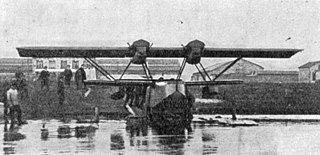Related Research Articles

The Curtiss Models F made up a family of early flying boats developed in the United States in the years leading up to World War I. Widely produced, Model Fs saw service with the United States Navy under the designations C-2 through C-5, later reclassified to AB-2 through AB-5. Several examples were exported to Russia, and the type was built under license in Italy.

The Norman Thompson N.T.4 was a twin-engined British flying boat of the First World War. Although less well known than similar Curtiss and Felixstowe flying boats, 50 were ordered for Britain's Royal Naval Air Service.

The FBA Type H was a French reconnaissance flying boat produced in large numbers in France and Italy during World War I by Franco-British Aviation.

The SIAI S.51, Savoia Marchetti S.51 or Savoia S.51 was an Italian racing flying boat built by SIAI for the 1922 Schneider Trophy race.
The Adolphe Bernard AB was a twin-engined French biplane aircraft, built near the end of the First World War. Ten AB 1 BN2 bombers were produced for the Armée de l'Air but did not reach squadron service; post-war, two civil derivatives were considered but only one aircraft was built.

The Hanriot HD.15 was a French two-seat fighter aircraft fitted with a supercharger for good high altitude performance, built in the 1920s. Three were ordered by Japan but lost at sea during delivery.

The Caudron C.74 was a ten-seat, four engine passenger biplane built in France in 1922. It showed promise but the sole prototype crashed fatally in a competition and no more were completed.

The Caudron C.23 was a French long range twin engine night bomber, flown in the last year of World War I. Post-war some machines were modified to carry passengers.

The Dornier Do S was a 22-passenger flying boat airliner flown in Germany in 1930.

The Hanriot H.38 was a French twin-engined sesquiplane flying boat built in the mid-1920s. Though the sole prototype was fitted with two defensive machine gun posts. the H.38 was described at the time as a utility aircraft.

The CAMS 54 was a strengthened and more powerful version of the French CAMS 51 civil transport and naval reconnaissance flying boat, developed for transatlantic flights. It is sometimes referred to as the 54 GR.

The Blériot-Spad S.45 was a large, four engine French airliner which appeared at the 1921 Paris Salon. It could carry fifteen passengers or be adapted as a bomber.
The Hess H-2 Blue Bird was a small US transport biplane, built in the 1920s and carrying two or four passengers according to engine power.

The Ireland Neptune was a four or five place pusher configuration biplane sold in flying boat and amphibian versions. Designed in the U.S. and first flown in 1927, well over 50 were built.

The Hiro H3H1 or Navy Type 90-1 Flying boat was a Japanese flying boat bomber built in 1931. It was the first large all-metal aircraft built in Japan. Only one was completed.
The Itoh Emi 3 was the first Japanese civil passenger carrying seaplane, flown in 1917 and used for commercial demonstrations and passenger flights.
The Itoh Emi 13 was a two seat Japanese trainer, designed for the Itoh flying school and introduced in two versions in 1920 and 1921.
The Itoh Emi 14 was a Japanese biplane designed in 1920 for a long distance competitive flight from Tokyo to Osaka and back, which it won. It was also successful at a contest later that summer, before suffering terminal structural failure during aerobatics a few weeks later.
The Itoh Emi 29 Taihoku-go was a 1920s Japanese civil transport with its two passengers in a enclosed cabin. It was the first of this "limousine" type to be built in Japan; the only example flew the Osaka-Tokyo route for a while.
The Itoh Emi 30 was a small, single-engined, sports biplane built in Japan in 1922. Though it attracted attention by being the smallest Japanese aircraft of its time, the sole example was mostly used as an aerobatics trainer.